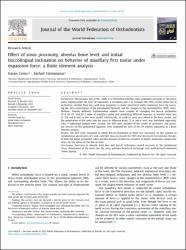| dc.contributor.author | Camcı, Hasan | |
| dc.contributor.author | Salmanpour, Farhad | |
| dc.date.accessioned | 2022-05-11T13:57:24Z | |
| dc.date.available | 2022-05-11T13:57:24Z | |
| dc.date.issued | 30.12.2021 | en_US |
| dc.identifier.citation | Camcı, H., & Salmanpour, F. (2022). Effect of sinus proximity, alveolar bone level, and initial buccolingual inclination on behavior of maxillary first molar under expansion force: a finite element analysis. Journal of the World Federation of Orthodontists, 11(2), 60-67. | en_US |
| dc.identifier.issn | 2212-4438 | |
| dc.identifier.uri | https://doi.org/10.1016/j.ejwf.2021.12.001 | |
| dc.identifier.uri | https://hdl.handle.net/20.500.12933/981 | |
| dc.description.abstract | Background: The primary aim of this study is to determine whether sinus proximity increases or decreases molar tipping under the force of expansion; a secondary aim is to compare the effect of the initial buccal inclination, alveolar bone loss, and sinus proximity to molar movement under expansion force, by assessing the stress distribution of the periodontal ligament and the changes in the moment/force (M/F) ratio).
Methods: Twenty different 3-dimensional models were created by changing the buccal inclination (0°,5°,10°,15°, and 20°) value of maxillary molar and simulating different amounts of alveolar bone loss (0, 2,4, and 6 mm) in the basic model. Additionally, an artificial sinus was added to the basic model, and the penetration of the roots into the sinus to different levels (2, 4, and 6 mm) was simulated separately. Thus, 9 additional models were created. The M/F ratio, location of the center of resistance, and principal stresses on the periodontal ligament were analyzed for each of the 29 models separately in a finite element analysis.
Results: The M/F ratio increased as initial buccal inclination or bone loss increased. As the amount of simultaneous penetration of 3 roots into the sinus increased, the M/F ratio decreased. Incremental changes of both the initial inclination value and the amount of bone loss resulted in higher maximum compressive stress on the apices of the buccal roots.
Conclusions: Increases in alveolar bone loss and buccal inclination caused increases in the periodontal stress. Penetration of the roots into the sinus provides bicortical anchorage and could prevent unwanted crown tipping. | en_US |
| dc.language.iso | eng | en_US |
| dc.publisher | Elsevier | en_US |
| dc.relation.isversionof | 10.1016/j.ejwf.2021.12.001 | en_US |
| dc.rights | info:eu-repo/semantics/embargoedAccess | en_US |
| dc.subject | Alveolar bone loss | en_US |
| dc.subject | Initial molar inclination | en_US |
| dc.subject | Periodontal stress | en_US |
| dc.subject | Sinus proximity | en_US |
| dc.title | Effect of sinus proximity, alveolar bone level, and initial buccolingual inclination on behavior of maxillary first molar under expansion force: a finite element analysis | en_US |
| dc.type | article | en_US |
| dc.authorid | 0000-0003-0824-4192 | en_US |
| dc.department | AFSÜ, Diş Hekimliği Fakültesi, Klinik Bilimler Bölümü | en_US |
| dc.contributor.institutionauthor | Camcı, Hasan | |
| dc.identifier.volume | 11 | en_US |
| dc.identifier.issue | 2 | en_US |
| dc.identifier.startpage | 60 | en_US |
| dc.identifier.endpage | 67 | en_US |
| dc.relation.journal | Journal of the World Federation of Orthodontists | en_US |
| dc.relation.publicationcategory | Makale - Uluslararası Hakemli Dergi - Kurum Öğretim Elemanı | en_US |
















